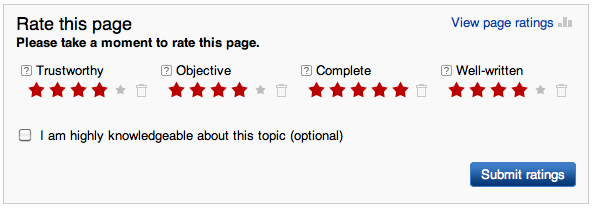
Today on English Wikipedia we rolled out the Article Feedback Tool – previously featured on 3,000 English Wikipedia articles – to a larger set of 100,000 articles. This initial expansion is intended to further assess both the tool’s value and its performance characteristics, with an eye to a full deployment on Wikipedia and potentially other projects.
Some examples of articles that currently feature the tool (at bottom):
The intent of the tool is two-fold:
- to gain aggregate quality assessments of Wikimedia content by readers and editors;
- to use as an entry vector for other forms of engagement.
To assess its value in both categories, we’ve already undertaken a significant amount of qualitative and quantitative research. You can read an extensive summary of our work so far here.
The high level summary based on the data we’ve seen so far: We believe user ratings can be a valuable way to predict high and low quality content in Wikimedia, and we’re especially interested in engaging raters beyond the initial act of assessing an article. Through our trials to date, we’ve seen very good conversion rates on the calls-to-action that follow a rating, suggesting that this could be a powerful engagement tool as well.
Beyond continuing our own research and these engagement experiments, our goal is to regularly make available anonymized data from the tool, and to supply editors with a dashboard tool for surfacing trends in the rating data. We’re looking forward to sharing wider findings from the use of the tool soon.
Please use the talk page or comment below for feedback, questions and suggestions.
Erik Moeller, Deputy Director

Can you help us translate this article?
In order for this article to reach as many people as possible we would like your help. Can you translate this article to get the message out?
Start translation